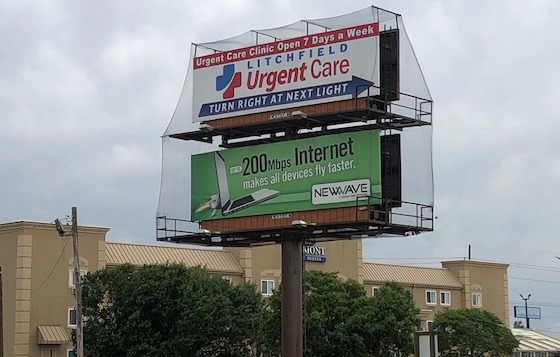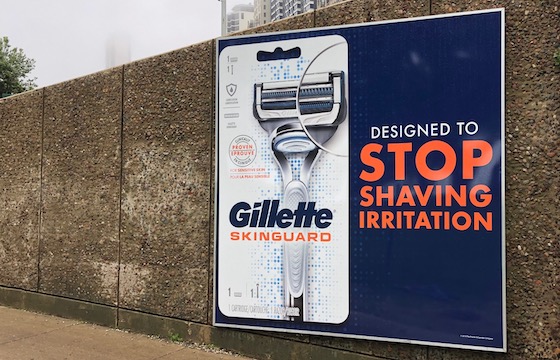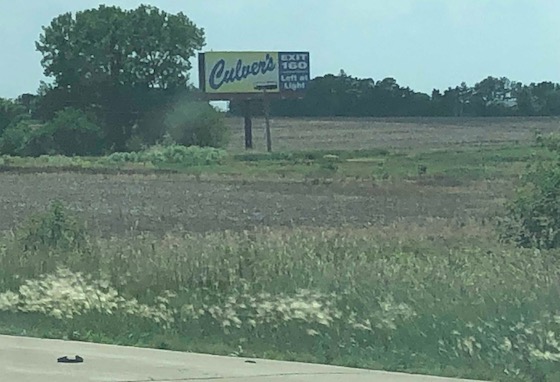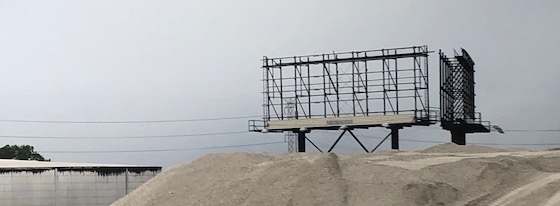Memo From Frank
I recently drove over 5,000 miles across the U.S. And it was very interesting to see the regional changes in the type of billboards along the highway. In the Great Plains (the breadbasket of the U.S.) were short signs with a huge amount of wooden-telephone pole construction since there is little to black the signs other than corn stalks. In the Midwest, there were more steel monopole structures to get the signs above the tree line and out of the way of businesses below. These monopoles grow taller as you reach the northeast and regions like Pennsylvania where there are mountains and all types of topography to try and climb above. And in the southern states the stack unit is prevalent, probably to drive down the cost of each billboard ad panel to meet perhaps lower budgets of advertisers. Most people drive along the highway and don’t even think about the billboards they see. All I do is think about the billboards.
Billboards Vs. Birds: A Primer

Billboards and birds have never gotten along well together. Even though they share the same first two letters, that’s about all that they can see eye to eye on. Birds like to congregate on billboards and that creates a problem in many ways. So what do you do about birds?
It’s a landowner problem – not a billboard problem
First of all, the problem with birds is not the damage they do to the sign. Rarely does the existence of birds cause the billboard ad copy to get messed up, or the sign structure to be damaged. Instead, the damage that birds do is to the property below. More specifically, to cars parked below, which can literally become wastelands of bird poop within mere minutes. So the only signs that typically need some type of bird deterrent are those with cars under them (parking lots for the most part). Otherwise, it’s not really an issue.
The solutions all have drawbacks
Unfortunately, nobody has ever come up with the perfect solution to the bird problem. There are basically four types of bird deterrents on the market:
\- Motion devices to scare birds off.
- Netting that blocks birds from landing on the billboard (shown in the photo above).
- Chemicals that are sticky on bird’s feet that they find uncomfortable to roost on.
- Decoys of predatory birds that scare off potential prey from landing on the sign (typically owls).
What works best
None of these is perfect. The netting makes the billboard less attractive to advertisers. The fake owl decoy loses it’s terror over time (I’ve seen birds sitting on the head of the owl once they realize it’s a fake). The motion devices break down over time. The chemicals wear off over time. Sadly, this is a very imperfect science.
In today’s politically correct world, you have to be careful about the impact on the birds
Perhaps more dangerous than the birds is the potential risk of bird lovers complaining about the impact the sign’s devices may have on the animal kingdom. Fortunately, none of these deterrents can really cause widespread harm (although the chemical route can actually kill birds if installed too thick). If they ever invented a solution that actually harmed birds I would not use it or you might end up on TV.
Conclusion
Most billboard owners only install bird deterrents when the property owner underneath demands it. But these are rarely successful in their mission and the only true solution is for people to learn to not park underneath them.
How To Make Money With “Out-Of-Home” Concepts

Have you ever seen walls and thought “I wonder if there’s a way to make that into a sign”? There’s a whole industry in pioneering those concepts. From sports stadiums to airports, plain walls can be transformed into income-producing advertising niches. The opportunities are all around you.
Watch for areas of high foot traffic
Any out-of-home concept starts with the need for viewer traffic. The alley behind your house might be easy for you so attach a sign to your fence, but only 10 people would walk by it a week. Instead, look for busy pedestrian areas. Of course, the ones we all think about are already taken: airports, sports stadiums, and malls, for example. But there are many other potential spots that have not yet been taken advantage of, with more new ones being built every day.
Exempt from most laws
Although the Highway Beautification Act of the 1960s put limitations on the placement of billboard signs along highways and major roads. But it does not control the placement of signs that are not seen from roads. Instead, you will have to only follow the rules of the city or county in most cases. This is extremely important because that means there are no limitations and permits to pull, which makes your job much easier and faster.
It’s like a bicycle – once you know how to do billboards you can master them all
One interesting thing about the entire out-of-home business (billboards, etc.) is that if you can do one, you can do them all. Same process, same leasing plan, same skills. So, just like a bicycle, you only have to learn how to do it once. That makes things very efficient – some billboard owners even have other divisions of things such as mobile billboards.
The plan is 1) make a prototype 2) succeed in one location 3) scale
The game plan is simple. You need to spot the opportunity, build a prototype display, make that first test a success, and then scale the project. You need that first portfolio piece, not only for operational track-record, but to often gather investor and bank financing to grow the concept. This is a very safe to way to build a business, as you can’t get ahead of yourself and are not gambling on a non-proven concept.
Some recent examples
The best example of success in the out-of-industry are the “logo” signs at virtually every exit on the national highway system. That started as a simple concept, got ratified by the highway department in one state as to the fact they have exemptions from typically billboard placement, and then built the signs and rented the ad space. Today, that simple experiment has grown into a billion-dollar business.
Conclusion
There’s a whole world of opportunity in the out-of-home industry beyond the billboard business. But they are all tied together with the same simple skill set, and once you know how to do one, you can do them all.
The Ultimate Billboard Boot Camp
![]() How to Find a Billboard Location
How to Find a Billboard Location
![]() How to Buy a Billboard
How to Buy a Billboard
![]() How to Build a Billboard
How to Build a Billboard
![]() How to Operate a Billboard
How to Operate a Billboard
![]() How to Rent Ad Space on a Billboard
How to Rent Ad Space on a Billboard
![]() How to Sell a Billboard
How to Sell a Billboard
Get Your Copy Now!
Using One Loophole In The Highway Beautification Act To Make Money

Have you ever passed by large billboards located extraordinarily farther back from the road than the other signs? It seems odd, but the truth is that there is a good reason for those signs to be in those locations. It’s all based on a loophole to the law that was discovered after the ordinance was passed.
What is the loophole?
Although you have to review the laws of each state for their own potential adoption of changes to the federal law, but in most states only signs that are within roughly 660’ of the road are governed under the Highway Beautification Act of 1965. What happened was that the government had to define a space from the edge of the road that was controlled, and they just arbitrarily came up with around 660’ because in 1965 the technology to build bigger signs was not yet invented. Of course, time marches on, and modern billboards have little do with the 1965 models.
How to take advantage of it
Since signs located beyond roughly 660’ from the road are exempt from the ordinance, this may mean that you have no restrictions on how big a sign you can build as well as where you can place them. So the key is to find areas of high traffic in areas that billboards are not allowed within 660’ and put together a program to build new signs that are giant.
Some creative ideas
Since the goal is to build a giant sign, some people have found unique ways of doing that using simple items that don’t cost much. One example is the billboard owner in Colorado that installed on ad on a giant grain elevator (rumored to the largest sign in Colorado). In another instance, metal storage containers were utilized for the structure to attach the vinyl advertisement to.
Conclusion
If you are having difficulty getting permits to install new signs in certain markets, you might explore the option of doing an “end run” around the Highway Beautification Act and build beyond their limits of control. Check out all applicable state, county and city ordinances to see if this option might work for you.
This Billboard May Be An Opportunity For You

I saw this sign driving the highway recently, and it exemplifies all the things you should look for in opportunities to buy or takeover abandoned signs – as well as to buy signs inexpensively. So why can I tell this sign is a potential opportunity?
It has no ads on it
The first step in finding an opportunity like this is simply that the sign has to be vacant. That can come in three varieties: 1) no ad but panels on the sign 2) an advertisement on the sign that expired many months or years ago (such as an announcement of a circus coming to town that’s dated two years ago) or 3) no panels on the sign at all (just the structure framework). Of this three alternatives, the one that is most telling is where the panels have been entirely removed – it suggests that the sign owner has started to salvage parts off the sign and has given up on trying to rent it again.
It has a visibility issue – that can possibly be fixed
This particular sign has a degree of blockage – apparently from some type of concrete batching plant’s pile of materials. As a result, it looks like the sign owner had difficulty renting it and finally gave up on it. Even with serious blockage, it’s always possible to rent the sign at a lower cost. But another possibility is to cure the blockage. In this case, that would mean going to the concrete plant and seeing if they would simply keep the pile of materials a little lower – possibly by paying them a regular fee.
It was owned by a big company
The way you can tell this sign was owned by a larger company is the fact that you see discoloration on the skirting from where the shield was located (the nameplate that has the sign company owner’s name on it). Only larger companies normally bother with this step. In addition, you can see that the structure is large and expensive and well-built. The beauty of big company signs is that big companies are typically the first to crumple and give up when they have a problem. This is because none of the employees have any stake in the sign and could care less whether it’s occupied, vacant, or still standing.
Conclusion
There are big opportunities present in abandoned signs. When you see this type of situation, contact the owner of the sign (if you can tell who it is) and see if they want to sell cheap, or contact the property owner to see if you can take over operations of the existing sign.
The Unusual History Of Advertising And Airplanes

“Look, up in the sky, it’s a bird, it’s a plane – no, it’s a billboard”. Not something you’d hear on a Superman movie, but true none the less occasionally in some giant American population centers. Using airplanes to advertise has been around for nearly a century. There are two types: 1) “skywriting” in which the airplane releases smoke to write the words of the ad in the sky (like clouds) and 2) pulling a banner behind an airplane. Both of these have huge problems, which is why it is rarely seen these days. “Skywriting” died out because of environmental concerns as well as the extreme cost. Pulling a banner behind an airplane is a problem because not only is it expensive, but the ad is so small way up in the air that it’s hard to read (just look a the example shown above).
Although the relationship between the airplane and the advertising world has always been a positive one, it would appear that it is coming to an end.
